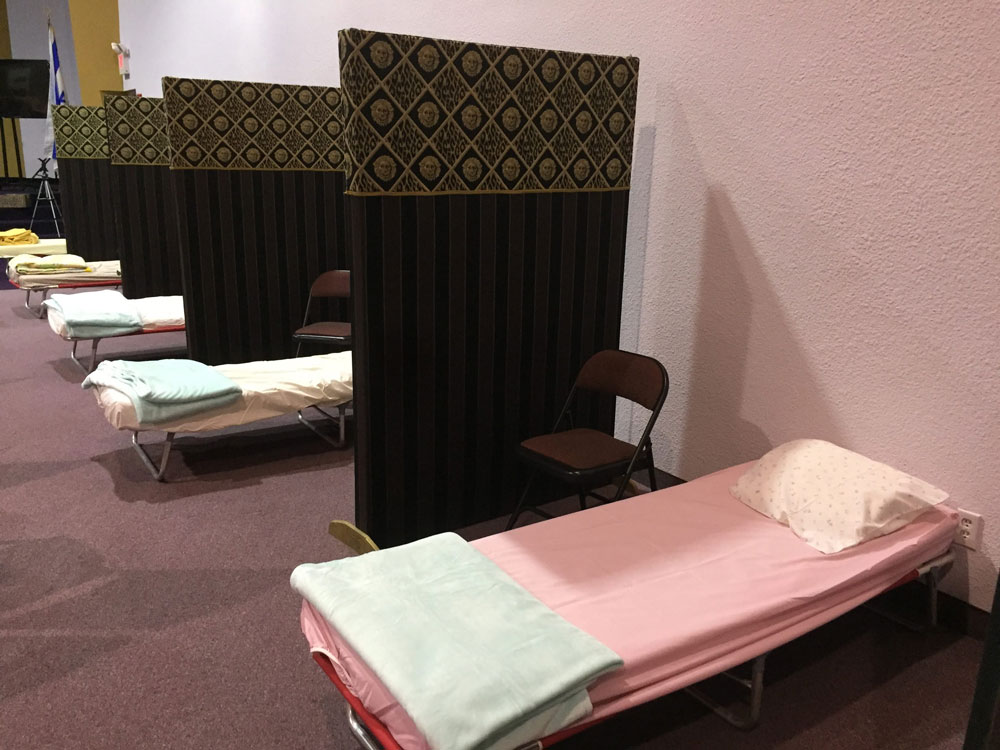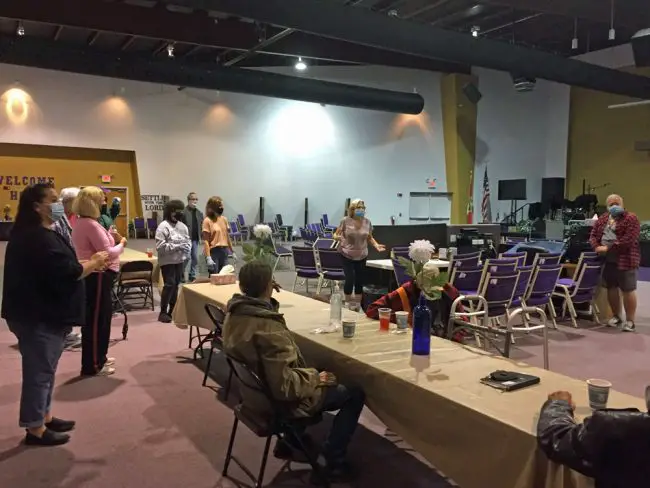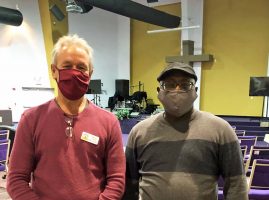
The Sheltering Tree, Flagler County’s only–and at times embattled–cold-weather shelter, for the first time this year Monday and Tuesday night opened its doors to 15 guests at its new location on the outskirts of Bunnell as temperatures dipped below 40 both nights.
For the first time in 12 years, the shelter was no longer at Fellowship Hall at First United Methodist Church in Bunnell, but 2 miles north and oceans away from former neighbors’ exasperation and resentments. The cold-weather shelter moved to Church on the Rock, the 14,000-square foot facility that has tripled the space available, and that also makes another first possible: the sheltering of homeless individuals who are covid-positive, or suspected of being so, as they can be isolated in a room of their own. The set-up, devised in consultation with the Flagler County Health Department, is similar to that of hurricane shelters.
“I like it very much,” says Martin Collins, a Sheltering Tree board member and volunteer who helped manage both nights. “I think the space is big, and coincidentally perfect because of coronavirus. It’s a very good, secure location. We’re happy to have an off-duty officer available all the time in the car park. It works well in terms of the toilets, the bathrooms, the location of the kitchen, our ability to set up a little TV area with a coffee stand, we have a lot of space and it’s very well laid out, very comfortable. I think it’s fair to say everyone has reacted well to it.”
Martin says the new arrangement takes nothing away from “how grateful we were for the Methodist location over all those years,” especially since the Sheltering Tree still operates its weekly outreach for the homeless and the needy every Tuesday from the Methodist Church, at 205 North Pine Street. But the set-up there had been made untenable by recurring conflicts with residential neighbors, who did not fancy the sight of homeless people hanging about the church and sheltering there, and, finally, by Bunnell government.
A year and a half ago the city took a hard line against the sheltering operation. Legally or not–that question has not been answered yet–the city administration invoked regulations essentially to lead to the equivalent of an eviction for the Sheltering Tree, with the backing of the city commission. The non-profit found reason to question the legality of the city’s reasoning and drew a U.S. Justice Department investigation of Bunnell’s actions. That stayed the city’s prohibition against sheltering operation last winter, which continued at the Methodist Church’s Fellowship Hall, if for just 12 nights: global warming has narrowed the span of colder nights.
It was then the county’s turn to hound the homeless: County Manager Jerry Cameron first clumsily and unsuccessfully attempted to ship the homeless off to an outlying camp, a plan that quickly fell apart after reporting illustrated the dismal and isolated conditions to which the county was fating the homeless. The administrator then devised a more cynical ploy to fence them off from the county’s land near the county library, where they had long been encamped, after declaring the land a construction zone that never was. Finally late last year, county government acknowledged what Bunnell had been pushing for since the shelter opened within its borders a dozen years ago: that homelessness is a shared responsibility.
A breakthrough occurred when Church on the Rock offered its facility as a potential site, at least on cold nights. By February, the Sheltering Tree had all but sealed that deal. County government, for its part, joined with Palm Coast, Bunnell and Flagler Beach in a co-equal agreement that would provide a modest sum of money to the Sheltering Tree–a non-profit that relies entirely on grants, donations and some 50 volunteers to run its operations. According to that agreement, The Sheltering Tree gets $1,000 per night for a maximum of 24 nights each winter season. The county and the cities will split the cost, each government paying up to $6,000–a dew drop in the bucket of government expenses that amounts to more of a symbolic gesture than a earnest aid, but still more than each government was willing to provide previously, which was nothing. For the shelter, the nightly $1,000 covers the rent of Church on the Rock and the steep cost of security for 12 hours, leaving little for the operation of the shelter itself. But no one is complaining.

The Church on the Rock provides three rooms for the shelter’s operations, allowing individuals to be spaced out. “We’re grateful for the fact that the county and the cities contribute toward the cost of running the shelter, and the rest is all done by volunteers,” Martin said. “So we have a welcoming team, we have a cooking team, we have an overnight team and we have a breakfast and cleanup team. Usually it’s about 15 to 20 volunteers, and the guests vary per night, because this is new and a new location.” There were five guests on Monday night, 10 on Tuesday night. “But we expect that to pick-up when the bus route is better known.”
The county is also providing a bus from its transportation fleet each night the shelter operates. The bus picks up homeless individuals at four locations in the county–Heroes Park in palm Coast, Veterans Park in Flagler Beach, and locations in the Hammock and Daytona North. The bus then drops off the same individuals the following morning. Each night the shelter operates, dinner is served at 6 p.m., a hot breakfast is served at 6 a.m., and guests are to be out of the shelter by 8 a.m.
Food preparation used to be done on-site when the shelter was at the United Methodist Church. Church on the Rock’s kitchen accommodations are not the commercial type, so preparation is done at volunteers’ homes and brought in, with meals taken within socially-distanced protocols. Masks are mandatory for all who are in the shelter–guests or volunteers. All volunteers were trained several times for their roles, Martin said. Every night, two Sheltering Tree board members walk through each team of volunteers through their assigned tasks. Sanitation is at a premium. Each evening’s set-up takes about three hours, each morning’s break-down takes about 90 minutes. It’s not a minor operation.
Bunnell City Manager Alvin Jackson stopped by the shelter on both nights, a gesture Martin saw as “reaching out the hand of friendship.”
“I think the Church on the Rock is a much better site,” Jackson said. “The way they have it laid out and the logistics, I think the facility just works so much better for them, I was very impressed. The security they have there, it’s not as cramped, I think the facility really works for them. They seem to be very satisfied from the first night. I did a walk-through before the first night before everyone started coming in.” For the city and its neighborhoods, “I think it’s a win-win, for our neighbors that basically were impacted they’re no longer being impacted. Then it’s a place where we can accommodate those that ended shelter during the cold weather time. So really, hats off to the county, Jerry, my other colleagues, the other cities and the attorneys, we worked through this, the Sheltering Tree and Church on the Rock, when you talk about a real collaborative relationship to address the need, this is the result.”
For the Sheltering Tree volunteers and the homeless, being at the outskirts of town, on a property that’s set back from U.S. 1, has been a boon of privacy, eliminating friction with neighbors and erasing the sense that the homeless were being imported into the city. Driving by, no one would know that the church was operating a cold weather shelter on those nights. And if homeless individuals used to be brought in from Volusia County previously, that’s no longer the case. Daytona Beach has its own homeless shelter.

Martin continued, “We helped a person recently who called us Tuesday and who told us after nine years she was being evicted. The owners of the building knew she had two disabled children,” one with multiple sclerosis, one with Down Syndrome. “We were able to pay two months’ rent and thank goodness she got her job back. So it’s pretty tough out there, and we’re seeing a lot more people come in who can’t pay their bills. We’re very worried if Congress doesn’t get an agreement in by the end of December. That’s going to stop the prevention of unemployment and the prevention of evictions.”
The Sheltering Tree’s own fund-raising operations have taken a hit. The organization relies on an annual dinner for the lion’s share of its fund-raising, usually in March. It raised nearly $12,000 at its 2019 event. This year those efforts had to be curtailed because of Covid, making the cities’ and county’s contribution that much more valuable. But the shelter’s needs are still dire and ongoing, since the Sheltering Tree’s outreach goes well beyond its cold-night services. The organization provides clothes, rental assistance, transportation, and numerous other aid to the needy throughout the year: a list of services and needs can be accessed here.
![]()





























MrsMatt says
Thank you FlaglerLive for this well written article.
Celia M Pugliese says
Thank you FlaglerLive for this article to make all county and cities residents aware of the hard dedicated work the Sheltering Tree does for our homeless. I am so glad that finally 3 cities and the county contribute a total of 24,000 a year to help the needy. Maybe a GoFundMe for the Sheltering Tree can be started given the absence for the 12,000 donated thru the Lions dinner because the pandemic. Volunteers like the one’s at the Sheltering Tree are what really makes the fabric of America the Great! Thank you.
E. Hoffa says
Helping Homeless in a County of 100,000+ is wonderful act of kindness, but 15 sounds like a very low number of homeless being helped!
Judy says
Please let us know where we can send our donation to and who to contact to volunteer.
Do local businesses offer collection options at check outs?
Good work!
jber
Cameron says
Hi Judy,
Thank you for your generosity. The Sheltering Tree’s mailing address is PO BOX 1219 BUNNELL FL 32110